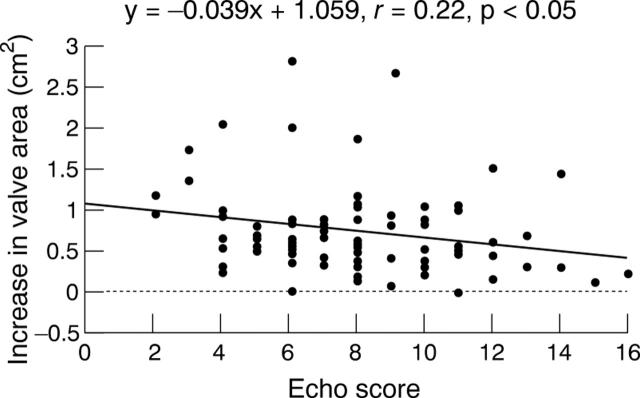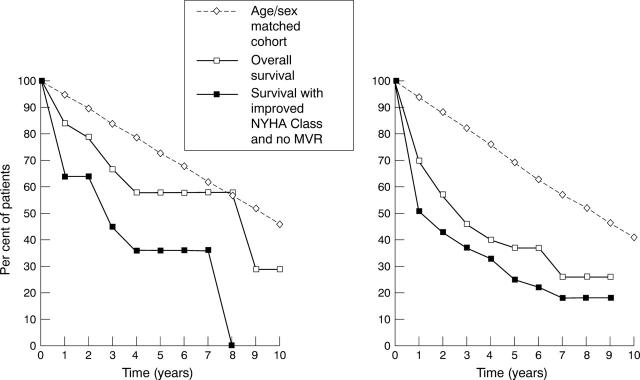Abstract
OBJECTIVE—To assess the immediate haemodynamic improvement and long term symptomatic benefit of percutaneous mitral balloon valvotomy in patients aged over 70 years. DESIGN—Pre- and postprocedure haemodynamic data and follow up for 1 to 10 years by clinic visit or telephone contact. SETTING—Tertiary referral centre in Scotland. SUBJECTS—80 patients age 70 and over who had mitral balloon dilatation: 55 were considered unsuitable for surgical treatment because of frailty or associated disease. In an additional four patients mitral dilatation was not achieved. MAIN OUTCOME MEASURES—Increase in valve area after balloon dilatation and survival, freedom from valve replacement, and symptom class at follow up. RESULTS—Mean (SD) valve area increased by 89% from 0.84 (0.28) to 1.59 (0.67) cm2. There was a low rate of serious complications, with only two patients having long term major sequelae. Of 55 patients unsuitable for surgical treatment, 28 (51%) were alive without valve replacement and with improvement by at least one symptom class at one year, and 14 (25%) at five years. In the 25 patients considered suitable for surgical treatment, 16 (64%) achieved this outcome at one year and nine (36%) at five years. CONCLUSIONS—Percutaneous mitral balloon valvotomy is a safe and useful palliative procedure in elderly patients who are unsuitable for surgery. Balloon dilatation should also be used for elderly patients whose valve appears suitable for improvement by commissurotomy, but echo score is an imperfect predictor of haemodynamic improvement. Keywords: mitral valve stenosis; balloon valvotomy; elderly patients
Full Text
The Full Text of this article is available as a PDF (129.1 KB).
Figure 1 .
Correlation between echo score and increase in valve area after mitral balloon dilatation.
Figure 2 .
Survival and clinical status following mitral balloon valvotomy in patients who were suitable (left panel) or unsuitable (right panel) for surgery, and age and sex matched cohorts.
Selected References
These references are in PubMed. This may not be the complete list of references from this article.
- Abascal V. M., Wilkins G. T., O'Shea J. P., Choong C. Y., Palacios I. F., Thomas J. D., Rosas E., Newell J. B., Block P. C., Weyman A. E. Prediction of successful outcome in 130 patients undergoing percutaneous balloon mitral valvotomy. Circulation. 1990 Aug;82(2):448–456. doi: 10.1161/01.cir.82.2.448. [DOI] [PubMed] [Google Scholar]
- Arora R., Nair M., Kalra G. S., Nigam M., Khalilullah M. Immediate and long-term results of balloon and surgical closed mitral valvotomy: a randomized comparative study. Am Heart J. 1993 Apr;125(4):1091–1094. doi: 10.1016/0002-8703(93)90118-s. [DOI] [PubMed] [Google Scholar]
- Ben Farhat M., Ayari M., Maatouk F., Betbout F., Gamra H., Jarra M., Tiss M., Hammami S., Thaalbi R., Addad F. Percutaneous balloon versus surgical closed and open mitral commissurotomy: seven-year follow-up results of a randomized trial. Circulation. 1998 Jan 27;97(3):245–250. doi: 10.1161/01.cir.97.3.245. [DOI] [PubMed] [Google Scholar]
- Cannan C. R., Nishimura R. A., Reeder G. S., Ilstrup D. R., Larson D. R., Holmes D. R., Tajik A. J. Echocardiographic assessment of commissural calcium: a simple predictor of outcome after percutaneous mitral balloon valvotomy. J Am Coll Cardiol. 1997 Jan;29(1):175–180. doi: 10.1016/s0735-1097(96)00422-6. [DOI] [PubMed] [Google Scholar]
- Carroll J. D., Feldman T. Percutaneous mitral balloon valvotomy and the new demographics of mitral stenosis. JAMA. 1993 Oct 13;270(14):1731–1736. [PubMed] [Google Scholar]
- Chen C. R., Cheng T. O., Chen J. Y., Huang Y. G., Huang T., Zhang B. Long-term results of percutaneous balloon mitral valvuloplasty for mitral stenosis: a follow-up study to 11 years in 202 patients. Cathet Cardiovasc Diagn. 1998 Feb;43(2):132–139. doi: 10.1002/(sici)1097-0304(199802)43:2<132::aid-ccd5>3.0.co;2-b. [DOI] [PubMed] [Google Scholar]
- Chen C. R., Cheng T. O. Percutaneous balloon mitral valvuloplasty by the Inoue technique: a multicenter study of 4832 patients in China. Am Heart J. 1995 Jun;129(6):1197–1203. doi: 10.1016/0002-8703(95)90404-2. [DOI] [PubMed] [Google Scholar]
- Cohen M. V., Gorlin R. Modified orifice equation for the calculation of mitral valve area. Am Heart J. 1972 Dec;84(6):839–840. doi: 10.1016/0002-8703(72)90080-4. [DOI] [PubMed] [Google Scholar]
- Edmunds L. H., Jr, Stephenson L. W., Edie R. N., Ratcliffe M. B. Open-heart surgery in octogenarians. N Engl J Med. 1988 Jul 21;319(3):131–136. doi: 10.1056/NEJM198807213190302. [DOI] [PubMed] [Google Scholar]
- Fatkin D., Roy P., Morgan J. J., Feneley M. P. Percutaneous balloon mitral valvotomy with the Inoue single-balloon catheter: commissural morphology as a determinant of outcome. J Am Coll Cardiol. 1993 Feb;21(2):390–397. doi: 10.1016/0735-1097(93)90680-y. [DOI] [PubMed] [Google Scholar]
- Inoue K., Owaki T., Nakamura T., Kitamura F., Miyamoto N. Clinical application of transvenous mitral commissurotomy by a new balloon catheter. J Thorac Cardiovasc Surg. 1984 Mar;87(3):394–402. [PubMed] [Google Scholar]
- Inoue K. Percutaneous transvenous mitral commissurotomy using the Inoue balloon. Eur Heart J. 1991 Jul;12 (Suppl B):99–108. doi: 10.1093/eurheartj/12.suppl_b.99. [DOI] [PubMed] [Google Scholar]
- Iung B., Cormier B., Ducimetiere P., Porte J. M., Nallet O., Michel P. L., Acar J., Vahanian A. Functional results 5 years after successful percutaneous mitral commissurotomy in a series of 528 patients and analysis of predictive factors. J Am Coll Cardiol. 1996 Feb;27(2):407–414. doi: 10.1016/0735-1097(95)00481-5. [DOI] [PubMed] [Google Scholar]
- Iung B., Cormier B., Farah B., Nallet O., Porte J. M., Michel P. L., Vahanian A., Acar J. Percutaneous mitral commissurotomy in the elderly. Eur Heart J. 1995 Aug;16(8):1092–1099. doi: 10.1093/oxfordjournals.eurheartj.a061052. [DOI] [PubMed] [Google Scholar]
- Kaplan J. D., Isner J. M., Karas R. H., Halaburka K. R., Konstam M. A., Hougen T. J., Cleveland R. J., Salem D. N. In vitro analysis of mechanisms of balloon valvuloplasty of stenotic mitral valves. Am J Cardiol. 1987 Feb 1;59(4):318–323. doi: 10.1016/0002-9149(87)90806-x. [DOI] [PubMed] [Google Scholar]
- Nair C. K., Biddle W. P., Kaneshige A., Cook C., Ryschon K., Sketch M. H., Sr Ten-year experience with mitral valve replacement in the elderly. Am Heart J. 1992 Jul;124(1):154–159. doi: 10.1016/0002-8703(92)90934-n. [DOI] [PubMed] [Google Scholar]
- Nicolaou N., Kinsley R. H. Mitral valve replacement in the elderly. S Afr Med J. 1984 Apr 14;65(15):598–600. [PubMed] [Google Scholar]
- Palacios I. F., Tuzcu M. E., Weyman A. E., Newell J. B., Block P. C. Clinical follow-up of patients undergoing percutaneous mitral balloon valvotomy. Circulation. 1995 Feb 1;91(3):671–676. doi: 10.1161/01.cir.91.3.671. [DOI] [PubMed] [Google Scholar]
- Parsonnet V., Dean D., Bernstein A. D. A method of uniform stratification of risk for evaluating the results of surgery in acquired adult heart disease. Circulation. 1989 Jun;79(6 Pt 2):I3–12. [PubMed] [Google Scholar]
- Patel J. J., Shama D., Mitha A. S., Blyth D., Hassen F., Le Roux B. T., Chetty S. Balloon valvuloplasty versus closed commissurotomy for pliable mitral stenosis: a prospective hemodynamic study. J Am Coll Cardiol. 1991 Nov 1;18(5):1318–1322. doi: 10.1016/0735-1097(91)90555-n. [DOI] [PubMed] [Google Scholar]
- Reyes V. P., Raju B. S., Wynne J., Stephenson L. W., Raju R., Fromm B. S., Rajagopal P., Mehta P., Singh S., Rao D. P. Percutaneous balloon valvuloplasty compared with open surgical commissurotomy for mitral stenosis. N Engl J Med. 1994 Oct 13;331(15):961–967. doi: 10.1056/NEJM199410133311501. [DOI] [PubMed] [Google Scholar]
- Roth R. B., Block P. C., Palacios I. F. Predictors of increased mitral regurgitation after percutaneous mitral balloon valvotomy. Cathet Cardiovasc Diagn. 1990 May;20(1):17–21. doi: 10.1002/ccd.1810200105. [DOI] [PubMed] [Google Scholar]
- Shaw T. R., Turnbull C. M., Currie P., Flapan A. D., Pringle S., Lee B. C. A comparison of cylindrical and Inoue balloon techniques for mitral valvotomy in patients in the United Kingdom. Br Heart J. 1994 Nov;72(5):486–491. doi: 10.1136/hrt.72.5.486. [DOI] [PMC free article] [PubMed] [Google Scholar]
- Shrivastava S., Mathur A., Dev V., Saxena A., Venugopal P., SampathKumar A. Comparison of immediate hemodynamic response to closed mitral commissurotomy, single-balloon, and double-balloon mitral valvuloplasty in rheumatic mitral stenosis. J Thorac Cardiovasc Surg. 1992 Nov;104(5):1264–1267. [PubMed] [Google Scholar]
- Turi Z. G., Reyes V. P., Raju B. S., Raju A. R., Kumar D. N., Rajagopal P., Sathyanarayana P. V., Rao D. P., Srinath K., Peters P. Percutaneous balloon versus surgical closed commissurotomy for mitral stenosis. A prospective, randomized trial. Circulation. 1991 Apr;83(4):1179–1185. doi: 10.1161/01.cir.83.4.1179. [DOI] [PubMed] [Google Scholar]
- Wilkins G. T., Weyman A. E., Abascal V. M., Block P. C., Palacios I. F. Percutaneous balloon dilatation of the mitral valve: an analysis of echocardiographic variables related to outcome and the mechanism of dilatation. Br Heart J. 1988 Oct;60(4):299–308. doi: 10.1136/hrt.60.4.299. [DOI] [PMC free article] [PubMed] [Google Scholar]




